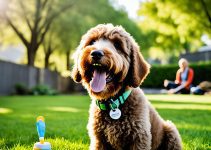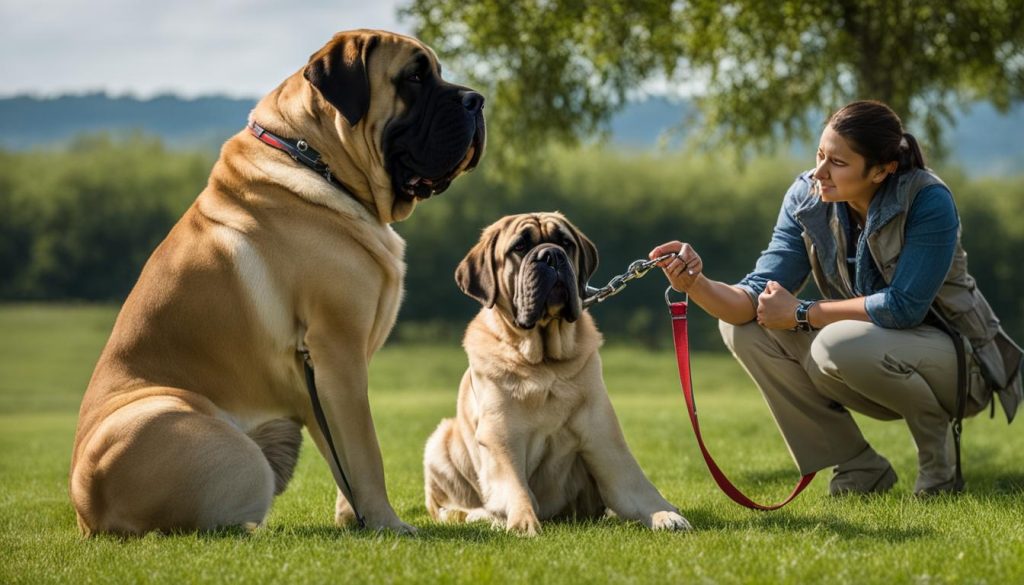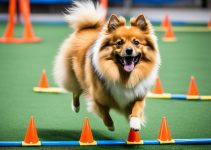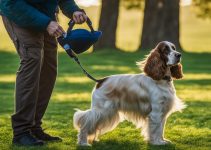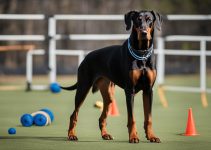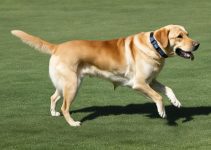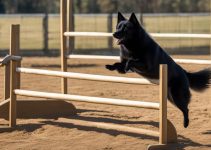Training and socialization are crucial for English Mastiffs due to their size and potential for misbehavior. Mastiffs can be stubborn, so patience, consistency, and positive reinforcement are key. Training and socialization costs should be seen as an investment in the well-being of the dog and to prevent potential behavioral issues. Once trained, English Mastiffs are known for their calm and patient nature.
English Mastiff Training – Easy Guide
- Training and socialization are essential for English Mastiffs.
- Patience, consistency, and positive reinforcement are crucial in training.
- Investing in training and socialization helps prevent behavioral issues.
- English Mastiffs have a calm and patient nature when properly trained.
- Maintain a loving and positive relationship with your Mastiff through gentle handling and positive reinforcement.
Training an English Mastiff Puppy
When it comes to training an English Mastiff puppy, starting early is key. Ideally, training should begin as soon as the puppy is ready to come home. The first 8-10 weeks of their life are crucial for socialization and learning behavioral norms.
Mastiffs are sensitive dogs, and negative reinforcement can harm the bond between you and your puppy. That’s why it’s important to focus on positive reinforcement methods. Rewarding your puppy with treats, praise, and play when they exhibit the desired behavior will help them understand and repeat those actions.
English Mastiff training should cover a range of areas, including housebreaking, obedience training, and setting boundaries. Housebreaking involves teaching your puppy to go potty outside and establishing a routine. Crate training can also be beneficial for both house training and providing a safe space for your puppy.
Introducing a crate to your Mastiff puppy can help them feel secure and prevent accidents inside the house. Make sure the crate is large enough for them to stand, lie down, and turn around comfortably. Gradually introduce your puppy to the crate by associating it with positive experiences, such as feeding and naptime. Remember to never use the crate as a form of punishment.
Consistency and patience are essential during the English Mastiff training process. Learning takes time, and Mastiffs can be stubborn at times. Keep training sessions short (around 10-15 minutes) and frequent, as their attention spans may vary.
Training an English Mastiff puppy requires starting early, using positive reinforcement techniques, and covering various aspects such as housebreaking and obedience training. By providing a secure and loving environment, you’ll be setting the foundation for a well-behaved and happy adult Mastiff.
Mastiff Obedience Training
When it comes to English Mastiff training, obedience commands are essential for instilling good behavior. Teaching basic commands such as sit, stay, come, lie down, and heel will help establish a strong foundation of obedience. These commands not only promote good manners but also ensure the safety of both the dog and those around them.
Fir an effective English Mastiff training, positive reinforcement is key. Use treats, praise, and petting as rewards to encourage desired behaviors. Mastiffs respond well to positive reinforcement, and it helps strengthen the bond between you and your furry companion.
Consistency and patience are vital during obedience training. Mastiffs can be stubborn, so it’s important to remain calm and persistent. Keep training sessions short, around 15 minutes, as Mastiffs may not repeat tasks as easily as other breeds. Break the English Mastiff training into small, manageable steps to maintain their focus and prevent them from becoming overwhelmed.
Remember to use clear, concise commands and provide immediate rewards to reinforce desired behaviors. This will help your Mastiff associate the command with the action. Be patient, as it may take some time for your Mastiff to fully grasp each command. With consistent training and positive reinforcement, your Mastiff will become well-versed in obedience and a joy to have by your side.
Mastiff Obedience Training Tips:
- Start training your Mastiff early to establish good habits and reinforce the desired behaviors.
- Use positive reinforcement techniques such as treats, praise, and petting to reward your Mastiff for following commands.
- Be consistent in your training approach, using the same commands and rewards each time.
- Keep training sessions short to maintain your Mastiff’s focus and prevent boredom.
- Break down each command into small steps, gradually increasing the difficulty as your Mastiff progresses.
- Stay patient and calm during training sessions, as Mastiffs can be stubborn and require extra time to learn commands.
To achieve successful obedience English Mastiff training, it’s important to establish a positive training environment and maintain a sense of consistency. By using effective training techniques and providing your English Mastiff with clear instructions and rewards, you can help them become a well-behaved and obedient companion.
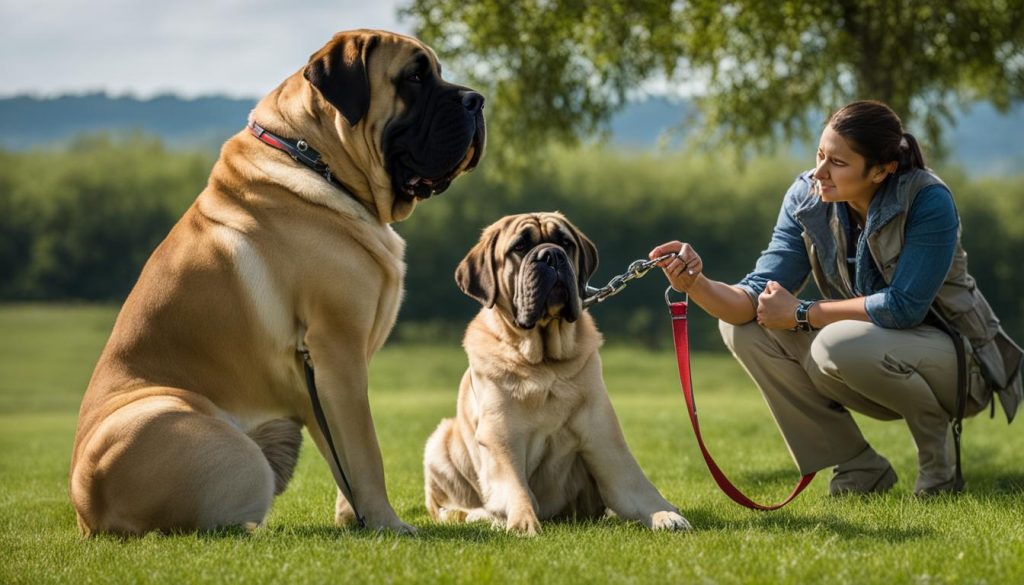
House Training an English Mastiff
House training an English Mastiff is an important part of their overall training process. By establishing a routine and being patient, you can effectively teach your Mastiff to become a well-behaved, house-trained companion.
One crucial aspect of house training is taking your Mastiff puppy outside regularly. This helps them associate going potty with being outdoors. Create a schedule that includes frequent bathroom breaks, especially after meals and naps. When your puppy eliminates outside, be sure to reward them with praise and a treat. Positive reinforcement is key in reinforcing the desired behavior.
While house training, it’s important to remember that accidents may happen, especially in the early stages. To mitigate potential messes, you may consider using puppy pads as a temporary solution. However, keep in mind that the ultimate goal is to transition your puppy to going potty outside. Gradually reduce the use of puppy pads as your Mastiff becomes more accustomed to going outside.
Crate training can also be beneficial for house training an English Mastiff. It provides a safe and secure space for your puppy when you can’t actively supervise them. Make sure the crate is appropriately sized to provide enough room for your growing Mastiff while still feeling cozy and secure. Introduce the crate gradually, allowing your puppy to associate it with positive experiences. Using treats and praise, encourage your Mastiff to enter the crate voluntarily. Remember, crates should never be used as a form of punishment.
By establishing a routine, using positive reinforcement, and incorporating crate training, you can successfully house train an English Mastiff. Patience and consistency are key during this training process, and with time, your Mastiff will learn to become a well-behaved and house-trained companion.
Leash Training for English Mastiffs
Leash training is a vital aspect of raising an English Mastiff due to their large size and strength. It is important to establish control and ensure the safety of both the dog and the owner during walks.
During leash training, positive reinforcement is key. Reward your Mastiff with treats, praise, or play for walking calmly on the leash. This will encourage them to associate the leash with positive experiences and reinforce desired behaviors.
Consistent Training and Proper Equipment
Consistency is crucial when it comes to English Mastiff training to walk on a leash. Use a sturdy leash and collar/harness that fits comfortably and securely. This will give you better control and prevent any discomfort for your Mastiff.
Introduce the leash gradually to your Mastiff, allowing them time to adjust to the new sensation. Start by simply attaching the leash and allowing the dog to walk around freely. Once they are comfortable, begin incorporating gentle guidance and commands.
Gradual Exposure and Distraction Management
It is important to expose your Mastiff to various environments and distractions during leash training. Start with quiet, familiar surroundings and gradually introduce more stimulating environments, such as parks or busy streets.
When your Mastiff encounters distractions, remain calm and redirect their attention back to you using positive reinforcement. This will help them stay focused and avoid pulling on the leash.
Behavioral Training for English Mastiffs
English Mastiffs, like any other breed, may exhibit certain behavioral tendencies that need to be addressed during training. Common behaviors in Mastiffs include mouthing, chewing, and jumping. It is important to address these behaviors early on to prevent them from becoming problematic habits.
Gentle and patient training methods are effective when training Mastiffs. Consistent positive reinforcement is key to shaping their behavior. This can be done through rewards, such as treats and praise, to encourage desired behaviors. Positive reinforcement helps create a positive association with training and strengthens the bond between the owner and the Mastiff.
In addition to positive reinforcement, proper socialization is essential for Mastiffs. Exposing them to different people, animals, and environments during their training helps them become well-rounded and adaptable. Socialization ensures that the Mastiffs are comfortable and behave appropriately in various situations.
By incorporating gentle English Mastiff training methods, consistent positive reinforcement, and proper socialization, English Mastiffs can learn to exhibit desirable behaviors. Investing time and effort in behavioral training will result in a well-behaved and balanced Mastiff that can bring years of companionship and joy.
Positive Reinforcement in Mastiff Training
When it comes to English Mastiff training, positive reinforcement should be your go-to technique. Mastiffs respond well to rewards and positive feedback, making it an effective way to shape their behavior and build a strong bond with them.
To utilize positive reinforcement effectively, consistency is key. Use treats, praise, and play to reward your Mastiff for exhibiting desired behaviors. This repetition helps reinforce those behaviors and encourages your dog to continue behaving positively.
Avoid negative reinforcement or punishment during Mastiff training. These gentle giants are sensitive creatures, and using negative methods can not only hinder their progress but also damage the trust and relationship between you and your Mastiff.
Remember, English Mastiff training requires patience, understanding, and positive reinforcement. Through consistent and rewarding training sessions, you can help your Mastiff become a well-behaved and loving companion.
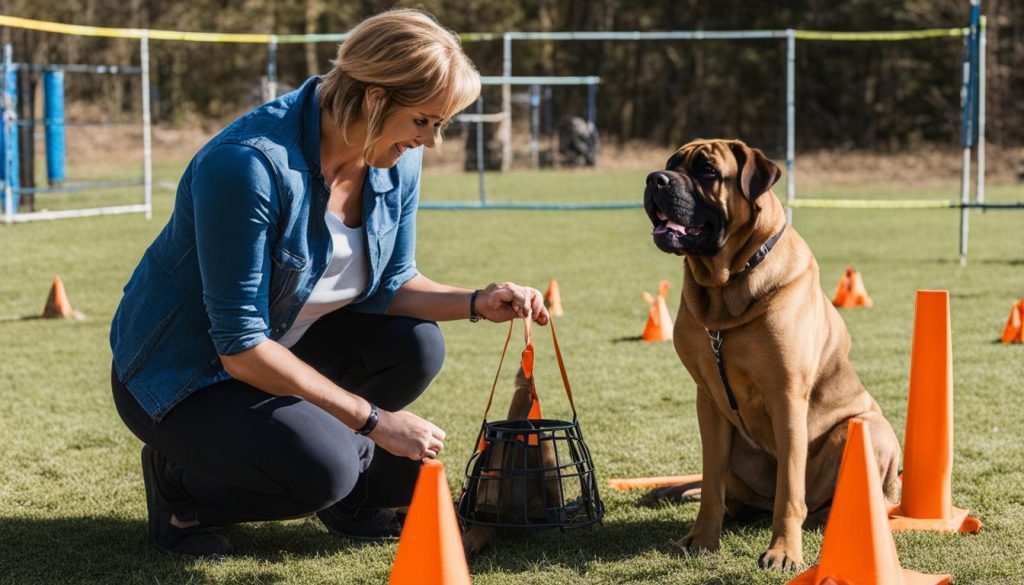
- Use treats, praise, and play to reward desired behaviors
- Consistency is key in reinforcing positive behavior
- Avoid negative reinforcement or punishment as Mastiffs are sensitive
Conclusion
In conclusion, training an English Mastiff requires a combination of patience, consistency, and positive reinforcement. Starting the training process early and focusing on socialization are essential for shaping their behavior and ensuring they become well-behaved companions.
Mastiffs can be stubborn, so it’s important to keep training sessions short and handle them gently. Positive reinforcement, using treats, praise, and play, should be the primary training method. This approach not only helps them learn but also strengthens the bond between you and your Mastiff.
With the right training and socialization, English Mastiffs can grow up to be well-behaved and loving pets. By investing time and effort into their training, you can enjoy the companionship of a confident and obedient Mastiff that brings joy to your life.
FAQ
What are some training tips for English Mastiffs?
Training an English Mastiff requires patience, consistency, and positive reinforcement. Start training early and focus on socialization. Use treats, praise, and play as rewards, and avoid negative reinforcement or punishment.
When should I start training my English Mastiff puppy?
Training should start as early as possible, ideally when the puppy is ready to come home. The first 8-10 weeks are critical for socialization and learning behavioral norms.
What basic obedience training commands should I teach my English Mastiff?
Basic obedience training commands like sit, stay, come, lie down, and heel should be taught to an English Mastiff. Positive reinforcement, such as treats, praise, and petting, can be used to encourage desired behaviors.
How do I house train an English Mastiff?
House training an English Mastiff involves establishing a routine and being patient. Take the puppy outside regularly, reward it for going potty outside, and create a walking schedule. Crate training can also be helpful for house training and providing structure.
How should I leash train my English Mastiff?
Leash training is crucial for English Mastiffs due to their size and strength. Use positive reinforcement, reward the dog for walking calmly on the leash, and use a proper-fitting, sturdy leash and collar/harness. Gradual exposure to different environments and distractions can enhance leash training.
How can I train my English Mastiff to exhibit good behavior?
English Mastiffs may exhibit behaviors like mouthing, chewing, and jumping. Gentle and patient training methods, along with consistent positive reinforcement, can help shape desired behavior. Proper socialization and exposure to different people, animals, and environments should also be part of their behavioral training.
What role does positive reinforcement play in Mastiff training?
Positive reinforcement, using treats, praise, and play, should be the primary method of training for English Mastiffs. They respond well to rewards and positive feedback, and this approach helps build a strong bond with their owners. Consistency is key in using positive reinforcement to reinforce desired behaviors.
What should I keep in mind when training an English Mastiff?
Training an English Mastiff requires patience, consistency, and positive reinforcement. Starting training early and focusing on socialization are crucial for shaping their behavior. Mastiffs can be stubborn, so short training sessions and gentle handling are recommended. Positive reinforcement should be the main training method, using treats, praise, and play. With proper training and socialization, English Mastiffs become well-behaved and loving companions.

